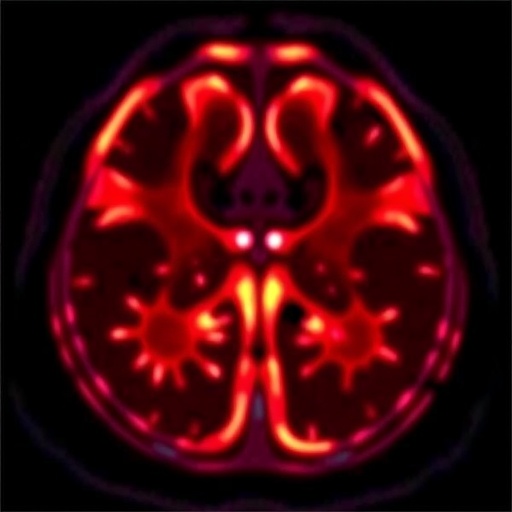A recent groundbreaking study from Guangxi Medical University Cancer Hospital has unveiled compelling evidence linking the early clearance of circulating Epstein-Barr virus DNA (cEBV-DNA) to enhanced treatment efficacy and survival outcomes in patients with locally advanced nasopharyngeal carcinoma (laNPC). This discovery not only elucidates vital biological interactions but also paves the way for optimizing therapeutic strategies in this challenging cancer subtype.
Nasopharyngeal carcinoma, predominantly associated with Epstein-Barr virus (EBV) infection, poses significant treatment challenges due to its anatomical complexity and potential for aggressive progression. A hallmark of EBV-positive laNPC is the presence of circulating EBV DNA in the bloodstream, which serves as a tumor biomarker. The study in question retrospectively analyzed 173 patients treated between January 2018 and October 2022, aiming to characterize how the kinetics of cEBV-DNA clearance impacted tumor regression and survival rates following induction chemotherapy and concurrent chemoradiotherapy.
Employing sophisticated molecular assays, researchers meticulously quantified cEBV-DNA levels alongside volumetric tumor assessments. Statistical evaluations implemented Spearman correlation analyses to investigate associations between clearance time and tumor volume reduction, while survival analyses utilized Kaplan-Meier curves and multivariate Cox regression models. Significance thresholds were rigorously maintained at a p-value less than 0.05 to substantiate findings.
Remarkably, patients exhibiting early seronegative conversion of cEBV-DNA demonstrated significantly greater reductions in primary nasopharyngeal tumor volume (p = 0.024) and in left cervical lymph node metastases (p = 0.002). These tumor response improvements correlated robustly with survival metrics, as overall survival (p = 0.026) and progression-free survival (p = 0.016) rates were markedly superior in this cohort. This reinforces the notion that viral DNA clearance serves as a powerful biomarker reflecting tumor responsiveness and patient prognosis.
Interestingly, the study observed no significant difference in volume reduction of right cervical lymph nodes based on cEBV-DNA clearance status (p = 0.233), suggesting potential asymmetry in lymphatic response or tumor biology that warrants further exploration. Notably, evaluation of chemotherapy-related toxicities revealed no significant disparities between early and non-early clearance groups, underscoring that rapid viral DNA elimination does not exacerbate treatment side effects.
Multivariate Cox regression analyses identified critical independent predictors of poor overall survival, including smoking history (p = 0.018), suboptimal tumor response to therapy (p = 0.036), and the absence of supporting targeted therapy or immunotherapy regimens (p = 0.043). These insights provide a multidimensional risk stratification framework integrating behavioral, biological, and therapeutic factors influencing clinical outcomes.
From a mechanistic perspective, the prompt elimination of circulating EBV DNA likely reflects effective cytotoxic destruction of EBV-infected tumor cells, thereby reducing viral shedding into the bloodstream. This phenomenon may parallel tumor microenvironment alterations and immune system activation that favor tumor control. Consequently, monitoring cEBV-DNA kinetics could enable real-time treatment monitoring and personalized adjustments.
The implications of this research are multifold, suggesting that routine cEBV-DNA measurement could become an integral component of laNPC management protocols. Early identification of patients with delayed viral clearance might trigger intensified surveillance or adjunctive therapeutic interventions, potentially improving survival odds. Additionally, integrating molecular viral biomarkers with conventional imaging enhances precision medicine efforts.
Given the global burden of nasopharyngeal carcinoma particularly in endemic regions, this study’s findings bear significant translational value. Tailoring treatment plans based on viral clearance dynamics offers a cost-effective and non-invasive approach to improving patient stratification. Future investigations expanding on immune modulation and combinatorial treatment efficacy may further augment clinical benefit.
Moreover, the absence of increased toxicity in patients with early cEBV-DNA clearance suggests that intensified or prolonged therapies might be safely administered to achieve maximal viral suppression without compromising patient quality of life. This balance between efficacy and tolerability remains a cornerstone in oncology, emphasizing the potential utility of viral DNA metrics.
This pioneering research also highlights the necessity for comprehensive multidisciplinary interventions combining chemotherapy, radiotherapy, targeted agents, and immunotherapies. Such integrated approaches, guided by biomarker insights, stand to revolutionize outcomes for individuals suffering from nasopharyngeal carcinoma.
In summary, the early clearance of circulating EBV-DNA in patients with locally advanced nasopharyngeal carcinoma emerges as a potent, clinically relevant predictor of both superior short-term tumor response and enhanced long-term survival, without additional treatment-associated toxicity. The interplay between viral biology, tumor dynamics, and therapeutic response elucidated by this study sets the stage for innovations in personalized oncology care.
As nasopharyngeal carcinoma treatment evolves, real-time viral monitoring may become a standard adjunct, allowing oncologists to tailor and adapt therapies responsively. The integration of virological biomarkers promises to redefine prognostication and therapeutic success in EBV-driven malignancies, reaffirming the value of translational research bridging molecular biology and clinical practice.
This advancement reflects a paradigm shift in cancer treatment biology, emphasizing how viral pathogens embedded within tumors can profoundly influence disease trajectory and response to interventions. Harnessing this knowledge will continue to unlock novel avenues for combating virus-associated cancers with increased precision.
Given the cumulative evidence, the clinical community must prioritize further research to validate these findings across diverse populations and to investigate combination strategies that leverage viral DNA clearance as a therapeutic target and surrogate endpoint. Such endeavors will undoubtedly accelerate progress toward more effective, individualized therapies for nasopharyngeal carcinoma patients worldwide.
Subject of Research: Circulating Epstein-Barr virus DNA clearance and its predictive value for treatment response and survival in locally advanced nasopharyngeal carcinoma.
Article Title: Early circulating EBV-DNA clearance predicts enhanced short-term treatment response and survival benefit in locally advanced nasopharyngeal carcinoma.
Article References:
Lu, X., Zhu, L., Tan, B. et al. Early circulating EBV-DNA clearance predicts enhanced short-term treatment response and survival benefit in locally advanced nasopharyngeal carcinoma.
BMC Cancer 25, 1499 (2025). https://doi.org/10.1186/s12885-025-14888-1
Image Credits: Scienmag.com
DOI: https://doi.org/10.1186/s12885-025-14888-1





